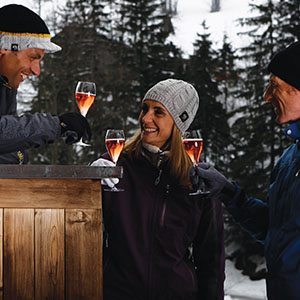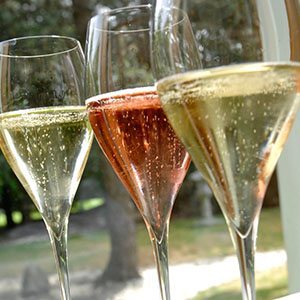Celebrated wine aficionado, Ron Kapon, who is known in wine circles as the Peripatetic Oenophile — the traveling wine expert — answers questions that Cheese Connoisseur readers have asked.
Cheese Connoisseur: My fiancée always wants to order Champagne when we go out to dinner but is there really much difference between it and sparkling wine? It can really be pricey.
Ron Kapon: Not sure which vintage your fiancée is ordering but Champagne can be very affordable, and yes, there is a difference. If a wine is not made from grapes grown in the French Government’s officially designated “Champagne Region,” then it cannot be labeled “Champagne.” All other wines, whether made according to the same méthode champenoise or by another process, are sparkling wines. In 2006, the United States and the European Union signed an agreement to end mislabeling of wines in the U.S. by prohibiting new labels with misleading names such as Champagne or Port. However, existing labels were “grandfathered in,” so today, more than 50 percent of the sparkling wine sold in the U.S. is still incorrectly labeled as Champagne. So perhaps your fiancé has been drinking something other than Champagne.
CC: I need to keep up with my fiancée about her “bubbly.” Can you tell me where in France the Champagne region is located?

RK: About 100 miles east of Paris. The high altitude and mean annual temperature of 50 degrees F presents a difficult climate for wine grapes to ripen. There are 84,000 acres of vines planted by 15,000 growers, 55 percent of whom own fewer than 2.5 acres. In addition, there are the “Houses” — 30 major producers such as Taittinger, Perrier-Jouet, Mumm, Veuve Clicquot, Moët — who account for two-thirds of total production and 90 percent of exports.
Forests that stabilize the temperature and keep moisture in the soil surround the area. The cold winters and warm summers mean that grapes barely ripen in most years. Ripening is helped by the chalky soil, which reflects sunlight upward to the vines. It also absorbs water during winter and releases it during summer. The wine made is light, with high acidity and low alcohol — perfect for a sparkling wine.
CC: What grapes are used to make Champagne?
RK: There are three grape varieties (with a few minor ones that are still allowed) used in the production of Champagne.
Pinot Noir: 38 percent of plantings; grown mainly on the slopes of the Mountain of Reims.
Pinot Meunier: 33 percent of plantings; grown mainly in the Marne River valley. Chardonnay: 29 percent of plantings; the major white grape variety, it is planted mainly in the Côte des Blancs. Chardonnay is the major variety allowed by law to be used to produce blanc de blancs (white from white grapes) Champagne.
CC: What is the best way to open a Champagne bottle if I want to stock up at home?
RK: Securely hold the bottle at a slight angle pointing away from you and remove the foil and wire cage from the cork. Do not aim the bottle at anyone. A bottle of Champagne contains up to six atmospheres of pressure, as much as a monster truck tire. Firmly grasp the cork by placing your palm — not fingers — over it and slowly twist the bottle, not the cork. As the cork begins to slide out, bend it sideways. It should make a small “sigh” as it comes out. It should not “pop” because that results in loss of bubbles, and no wine should erupt from the bottle because it will result in loss of wine.
CC: You referenced the method champenoise? What is secondary fermentation?
RK: Méthode champenoise is reserved for wines made in Champagne. Outside the area, even if a producer follows the exact steps, it must be referred to as méthode traditionnelle, or traditional method. All grapes are picked by hand.
The main steps are:
Pressing – The grapes are crushed in the normal way for making wine. If red grapes are used, the skins and juice are separated quickly to avoid deep coloration of the wines.
Fermentation – The first of two fermentations takes place, as with many other wines, in stainless steel or in older oak casks. Depending on the style of the producer, the wines may be allowed to undergo malolactic fermentation, in which stringent malic acid is converted to softer lactic acid.
Blending – Creating the cuvee. The winemaker blends wines from different vineyards and years.

First bottling and secondary fermentation – The wine is put in bottles with a small amount of yeast and sugar, and plugged with a temporary cap. The bottles are stored in cool, dark cellars for a minimum of 15 months for non-vintage to three years for vintage. During this time, the yeast and sugar interact and form the bubbles, or CO2, that defines the final product. It also produces spent yeasts, or lees.
Riddling and disgorging – remuage and dégorgement – During this time, the bottles are periodically elevated a bit and rotated, either by hand or by large machines, so that the top of the bottle faces the floor and the lees end up in the bottle neck. To remove the frozen sediment, the bottle is held upside down and the neck is frozen in salt-water brine. Pointing the bottle down into a receptacle, the temporary cap is removed, the frozen plug is expelled by the CO2, and the bottle is turned upright.
To make up for liquid lost, the bottle is topped up with a solution of wine and sugar and sealed with the permanent cork and wire muzzle. Dosage is used not only to “top up” a bottle of Champagne, but also as a balancing agent, much like salt in cooking, to help manage the very high levels of acidity. The degree of sweetness of the final Champagne depends on how much sugar is added. In fact, Champagne comes in many degrees of sweetness: Extra brut: less than .6 percent residual sugar; brut: less than 1.5 percent; extra dry: 1.2-2 percent; sec: 1.7-3.5 percent; demi-sec: 3.3-5 percent; and doux: more than 5 percent.
CC: What is the difference between non-vintage and vintage Champagne? My fiancée went gaga over some vintage variety?
RK: Producers may make either “non-vintage” or “vintage” Champagnes. Non-vintage is a blend of wines from several years. While most of the wine will come from a single year, producers blend in from 10-40 percent of wine from older vintages. If the producer decides that a particular year is of highest quality, they may choose to declare a vintage wine that must be composed of at least 85 percent of the vintage year grapes.

CC: What glassware do you recommend?
RK: Glasses are important. The flute glass has gained much popularity, but recent research done by scientists in France has shown that the tulip glass enhances the aromas of the wine. A few of the major Champagne houses have had special glasses designed for each of their prestige wines: Riesling-type glasses for white and Pinot Noir-shaped glasses for Pinot Noir-based or Rose Champagnes. Sounds like a set of beautiful glasses would be the perfect gift for your bride-to-be. CC



